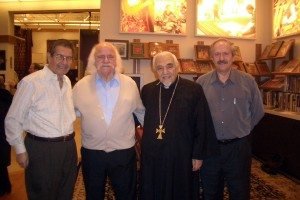As book talks and signings go, the Feb. 25 launching of Mitchel Kehetian’s Giants of the Earth assured the long-time newspaperman and editor his place in the literary sun.

Over 70 people gathered in the exquisite downtown Birmingham showroom of Hagopian World of Rugs to fete and congratulate native Detroiter Kehetian as he took them on a verbal odyssey to Turkish-held Armenian lands in search of Aunt Parancim, his father’s sister, thought to be among those who had perished in Khoops, Keghi during the Armenian Genocide.
This is the genocide whose veracity is endorsed by scores of world recognized scholars but still denied by the present-day Turkish government and left as an unfilled pre-election promise by President Obama.
Aunt Parancim had survived and her nephew was determined to locate this long-lost relative, daring to trek, in 1969, the remote and possibly dangerous terrains of the lands that lay in the shadow of Mt. Ararat, the biblical location of Noah’s Ark. Through the help of the U.S. State Department and his friend, Detroit Congressman Lucien Nedzi, Kehetian’s search began accompanied by a Turkish guide, Nur Tanisik, and an armed Kurdish driver and body guard, Mehmet Unlu.
Kehetian’s wiles ingratiated himself to these unlikely traveling companions who themselves began to understand this survivor’s son’s reason for a trip to the wastelands of Turkey. To his historical credit, Kehetian always refers to this territory as “Turkish-held Armenian land.” This is only one way he has of expressing his disdain of those who attempted to purge this territory of its Armenian inhabitants, whom he credits as being the “giants of the earth.”
The author resembles his Urartian ancestors with his fair complexion and eyes of blue, as he captured the silent audience with his narration as if it were only yesterday that the 1969 trip took place.
Kehetian has expressly written this book—deftly entwined with early Armenian history—for the third-generation of Armenians so they will know not only what happened in 1915 but have knowledge of other turbulent times—when Armenia lay on the crossroads of the spice and silk route—and its survival to the modern age. Armenia’s 4,000-plus years of existence is a fact every Armenian should embrace with pride. Kehetian has made this a complete guidebook.
The book began 40 years ago as a historical preservation project for Kehetian’s daughters—Grace, Janet, and Karen—and his grandchildren. The memoir is dedicated to his dear cousin, the late Rev. Fr. Vartan Kassabian, who convinced him to complete the mission, but who unfortunately passed away before the book’s publication.
So many coincidences took place that led the seasoned newspaperman to believe that only the hand of God could have played it out so keenly. From an accidental meeting of old friend Hamayag Kachadoorian in Moscow’s Metropole Hotel elevator (whom Mitch’s parents had hosted in Detroit as a former Displaced Person), to the old woman with him, Arousig Mangoian (who was from Khoops, Mitch’s father’s village, and who said her brothers had seen Aunt Parancim alive in 1947). This was the startling news that began it all.
Aunt Parancim’s survival of the genocide was an unexpected and bittersweet discovery. Only the hand of a benevolent God could have led to this, and Kehetian pursued and made good on all the coincidences.
***
The man with the pure white mustache and long fringe of white hair was in this showroom surrounded by the ambiance of magnificent oriental rugs reminiscent of the craft his Armenian ancestors had perfected. He concluded the book talk by saying, “High on a mountaintop overlooking the western tributary of the Biblical Euphrates River in Turkish-held Armenia, I found a crude, rocky gravesite…and the soul of my Armenian heritage. Out there in the desolate patch of earth called Kutluja I found Parancim.”
Through all the coincidences, fate was now to be unkind. Parancim had died only seven years before her nephew’s discovery of her gravesite.
The emotionally electrified audience stood to honor their Mitch Kehetian and Aunt Parancim, with those magnificent oriental rugs having no choice but to absorb the din and appreciation of this predominately Armenian audience.
In reality, every Armenian person here is in exile. In every person’s heart also lives the fear that some of their ancestors, too, were left behind and could only remain Armenian and Christian secretly in this wasteland.
An impressive kini-ahtzon ceremony followed and was vigorously performed by Rev. Fr. Diran Papazian of St. John’s Armenian Apostolic Church. He sang a sharagan (an Armenian church hymn) and repeated prayers. He both blessed the author and poured red wine on the pages of the new book welcoming Kehetian into the pantheon of Armenian writers, following in the footsteps of the Great Translators from hundreds of years before. A true honor. He was assisted by David Terzibashian.
This kini-ahtzon ceremony is also a living testimony to the Armenians’ devotion to Christianity. Priests are involved in many aspects of Armenian life. That which the Turks attempted to destroy, lives on stronger than ever.
Welcoming members of the Metro -Detroit community were hosts Edgar Hagopian, daughter Suzanne Hagopian, and Hagopian’s administrative assistant Pam Coultis. Videotaping the evening was filmmaker Hrayr Toukhanian of “Assignment Berlin” film fame.
The most beautiful line in a beautifully written memoir? “Yes, I am proud to be an American by birth, but more so I am thankful to God to have been given life with the soul of an Armenian.” Pure Kehetian.
“Akh-Tamar.”
Giants of the Earth, published and available only through Publish America, sells for $24.95. For more information, visit www.publishamerica.net/product88361.html.


Be the first to comment